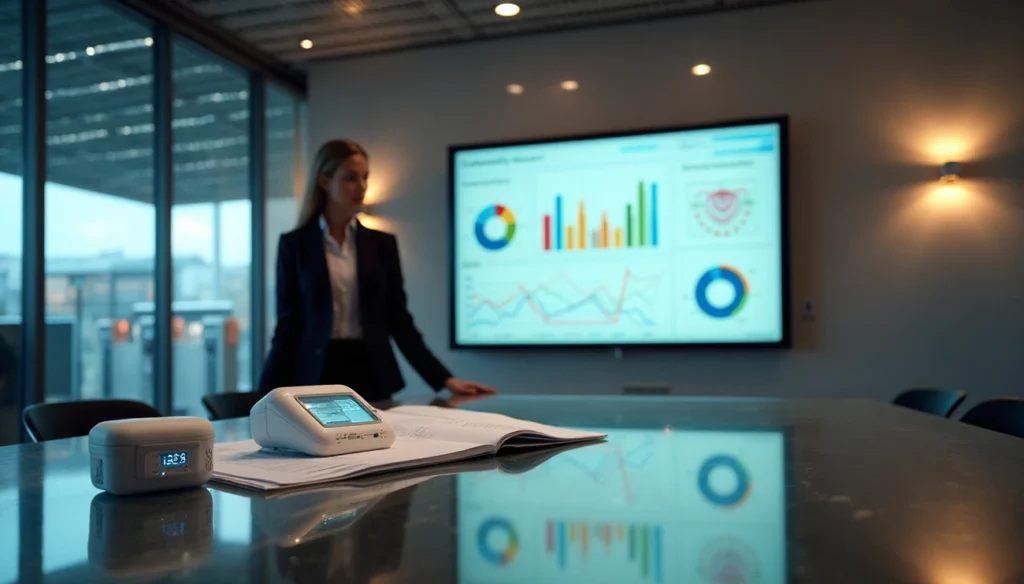

UK-based companies face a significant change in environmental reporting. Nearly 11,900 large companies must now disclose their annual energy use and carbon emissions under SECR reporting requirements.
The Streamlined Energy and Carbon Reporting (SECR) framework makes it mandatory for organizations to include their energy use and carbon emissions data in annual reports. This requirement applies to all quoted companies of any size, large unquoted UK-incorporated companies, and large limited liability partnerships (LLPs). A company’s size matters here. The “large” classification applies when a company meets at least two criteria: £36 million or more in turnover, £18 million or more in balance sheet assets, or more than 250 employees.
Companies meeting these thresholds have been providing SECR-compliant information in their Director’s Reports since April 1st, 2019. Low energy users might qualify for exemption if they consume 40MWh or less annually—about the same as 14 British homes’ yearly energy use. SECR’s introduction came as the Carbon Reduction Commitment (CRC) energy efficiency scheme ended, creating a more detailed framework for environmental accountability.
This piece explains everything about SECR reporting—from compliance requirements in 2025 to required disclosures, accurate reporting methods, and non-compliance penalties. The UK stands as a global leader in greenhouse gas emissions accounting and disclosure. That’s why knowing your SECR obligations matters both for regulatory compliance and environmental stewardship.
The Streamlined Energy and Carbon Reporting (SECR) framework marks a fundamental change in how the UK handles corporate environmental accountability. Let’s look at what SECR really means, why it took over from previous schemes, and how it fits with bigger climate goals.
The Companies (Directors’ Report) and Limited Liability Partnerships (Energy and Carbon Report) Regulations 2018 made SECR a required carbon and energy reporting framework. This framework came into force on April 1, 2019. UK-incorporated companies that qualify must now include their energy usage and carbon emissions in their yearly financial reports.
SECR gives businesses a standard way to measure, track, and report their environmental effect. UK-quoted companies, large unquoted companies, and large Limited Liability Partnerships (LLPs) must follow this framework. The SECR requirements now appear directly in annual reports instead of needing separate reporting.
These rules update the Large and Medium-sized Companies and Groups (Accounts and Reports) Regulations 2008 and the Limited Liability Partnerships (Accounts and Audit) (Application of Companies Act 2006) Regulations 2008. Companies now think about sustainability alongside their financial results.
The UK carefully planned SECR to take over from the Carbon Reduction Commitment (CRC) Energy Efficiency Scheme. Many saw the old CRC scheme as too complex and difficult for businesses to handle. Administrative challenges made the previous system less effective.
SECR was created to:
The old CRC rules applied to about 4,000 organizations. Now, SECR requirements affect roughly 11,900 UK-incorporated companies. This shows how serious the UK government is about making more companies environmentally accountable.
SECR helps the UK reach its legal target to achieve net-zero greenhouse gas emissions by 2050. Companies must report openly, which makes them more aware and responsible. This pushes them to find and use better energy-saving methods.
The system backs the UK’s climate strategy in several ways. Companies now actively manage and reduce their environmental impact. Stakeholders, including investors, customers, and employees, get clear details about company energy use and carbon footprints.
SECR matches what the G20 Financial Stability Board’s Taskforce on Climate-related Financial Disclosures recommends by giving investors and financial players key information. This openness helps the financial sector move toward an eco-friendly, low-carbon economy.
SECR adds to existing rules but doesn’t replace other programs like the Energy Saving Opportunity Scheme (ESOS), Climate Change Agreements (CCA), or the EU Emissions Trading Scheme (ETS). It works with these programs as part of a detailed plan for environmental care and climate action.
UK-based companies need to comply with SECR regulations in 2025 under three distinct categories. These rules will apply to about 11,900 companies, so it’s significant to know if your organization needs to follow them.
Every quoted company must follow SECR reporting guidelines. The regulations define these as “UK incorporated companies whose equity share is listed on the Main Market of the London Stock Exchange UK or in an EEA State, or admitted to trading on the New York Stock Exchange or Nasdaq.” UK subsidiaries of US-listed companies also fall under this category. These organizations already had greerules for reporting greenhouse gas emissionsd SECR builds upon them.
SECR rules go beyond public companies to cover large unquoted companies and Limited Liability Partnerships (LLPs). Charitable companies, organizations under Financial Conduct Authority (FCA) supervision, and Public Limited Companies (PLCs) that meet size requirements belong here. These entities should report their UK energy consumption and related greenhouse gas emissions.
Your organization qualifies as “large” under SECR by meeting any two of these conditions:
The size thresholds for unquoted companies’ SECR disclosures are not changing in 2025. Some medium-sized companies, LLPs, or groups might still need SECR disclosures in their annual reports for accounting periods starting after April 6, 2025.
Companies using less than 40 MWh of energy during the reporting period don’t need detailed SECR reporting. They just need to state their low-energy user status. To give you an idea, 40 MWh equals the yearly energy use of two average-sized homes. Your calculation should include electricity, gas, and transport fuels, including staff mileage claims. A typical diesel car covering 20,000 miles yearly uses about 22.8 MWh of energy.
Parent companies must report combined figures for themselves and their qualifying subsidiaries. SECR differs from schemes like ESOS because it doesn’t use a “one in, all in” approach. You can leave out energy and carbon information from subsidiaries that wouldn’t need to report on their own. However, if your subsidiary is large enough to need SECR reporting, you must include its data in group-level reports.
UK-based organizations meeting these criteria need to comply with SECR, even when their overseas parent company publishes similar reports. This approach gives a detailed picture of all qualifying UK businesses, whatever their international corporate structure.
SECR reporting requirements change by a lot based on your business type. To comply with the framework properly, you need to know exactly what to disclose.
Quoted companies must report their global Scope 1 and Scope 2 greenhouse gas emissions in tons of carbon dioxide equivalent (CO2e). These emissions come from all seven gases listed in the Kyoto Protocol. Scope 1 has direct emissions from sources the company owns or controls. This includes fuel combustion, company vehicles, and fugitive emissions. Scope 2 has indirect emissions from purchased electricity, heat, steam, and cooling. Companies must also share their underlying global energy use for the current reporting year.
Large unquoted companies and LLPs differ from quoted ones. They only need to report on UK energy use and associated GHG emissions. The report should cover electricity, gas, and transport fuel used within the UK and offshore areas. Transport energy reports must show fuel used in company-owned vehicles and employee vehicles where the company buys the fuel. However, fuel from third-party transport services, such as taxis, flights, or shipping, is excluded.
Different business types face different rules for Scope 3 reporting. Quoted companies can choose to report Scope 3 emissions—it’s voluntary but strongly encouraged. Large unquoted companies and LLPs must report some Scope 3 emissions. These include business travel in rental cars or employee vehicles where the company buys the fuel. Other Scope 3 categories remain optional but are recommended for material emission sources.
Organizations under SECR must include at least one emissions intensity ratio in their reports. These ratios help compare emissions with business metrics and track changes year after year as businesses grow or shrink. Common examples are tons of CO2e per million pounds of revenue, per square meter of floor space, or per ton of product.
Every SECR report needs a narrative description of principal measures taken during the financial year to improve energy efficiency. Companies should list specific actions and measure energy savings where possible. Examples include equipment upgrades, smart meter installations, eco-friendly transport solutions, or behavior change programs. Companies must state if they took no energy efficiency actions.
The accuracy of SECR reporting depends on choosing the right methods and setting clear boundaries. These technical elements shape how your organization measures and reports its environmental effect.
SECR legislation lets you choose your calculation method, but you need to be clear about which one you use. The government suggests several trusted independent standards:
These frameworks make your calculations strong, transparent, and easy to compare with other organizations. The GHG Protocol stands out as a popular choice because it offers detailed guidance and worldwide recognition.
You must decide on an organizational boundary approach before collecting data. This approach needs to stay consistent throughout your reporting:
Financial control boundary: Report emissions from operations where you have financial control—meaning you can direct financial and operating policies to get economic benefits.
Operational control boundary: Report emissions from operations where you have complete authority to implement operating policies, even with less than 100% ownership.
Equity share boundary: Report emissions based on your equity share percentage in each operation.
The operational control approach gives the most detailed view. Many organizations prefer financial control because it matches their financial reporting boundaries.
Primary data like meter readings and invoices are the foundations of your calculations. You can use estimates to fill data gaps if you’re open about your method.
Guidelines suggest keeping the materiality threshold between 2% and 5% of total emissions. You must explain what information you couldn’t include, how important it was, and your plans to get it for future reports.
The Financial Reporting Council created the SECR taxonomy in 2019 to standardize digital reporting. Digital filing isn’t required, but the government encourages it to make information more accessible to external users. Companies House and HMRC both support submissions using this taxonomy.
SECR differs from other regulatory frameworks by offering flexibility along with its compliance requirements. Knowing these provisions will help you handle reporting obligations more effectively.
SECR has a “comply or explain” clause that lets organizations skip certain information when data collection is truly not possible. Organizations should use this provision only in exceptional circumstances such as:
Organizations using this clause must clearly state the excluded information and explain why. Your statement should also describe how you plan to fill these data gaps in future reports. The Financial Reporting Council (FRC) might examine these explanations carefully, so justifications need to be reliable.
The FRC’s Conduct Committee oversees SECR compliance. The committee can start investigations if they suspect non-compliance. After finding discrepancies, the FRC might:
Companies House can reject submissions that lack required SECR information. This rejection could result in late filing penalties from £150 to £7,500.
Companies often face several hurdles while collecting accurate SECR data:
Climate Management and Accounting Platforms (CMAPs) offer excellent solutions for SECR compliance. These software-based tools:
External verification isn’t required but remains a recommended practice to ensure accurate data and build stakeholder trust.
SECR reporting has been a vital part of the UK’s environmental accountability framework since April 2019. UK businesses need to understand their obligations to avoid penalties and help achieve national climate goals. The requirements affect nearly 11,900 UK businesses, making compliance a common responsibility.
Your business needs to report under SECR if it meets at least two of three size criteria: £36 million turnover, £18 million balance sheet, or 250+ employees. Companies that use less than 40 MWh of energy yearly can claim exemption as low-energy users. They still need to declare this status.
Requirements vary based on business type. Quoted companies must report their global Scope 1 and 2 emissions. Unquoted companies and LLPs only need to report UK energy use and related emissions. Every organization must include an emissions intensity ratio and list their energy efficiency actions during the reporting period.
The GHG Protocol will give a reliable framework to report accurately. Clear organizational boundaries must be set using financial control, operational control, or equity share approaches. Estimates can fill data gaps when needed, but organizations should be transparent about these practices.
The “comply or explain” clause lets companies be flexible in exceptional cases. The Financial Reporting Council must approve these explanations. Companies that fail to comply might face rejected submissions, mandatory revised reporting, or public censures that hurt their reputation.
Climate Management and Accounting Platforms are a great way to get better at SECR reporting. These tools help solve common issues like inconsistent metering and data matching across locations.
SECR ended up serving more than just compliance. Standardized reporting helps your organization learn about energy usage patterns and shows stakeholders your commitment to the environment. This openness makes your business stronger in today’s sustainability-focused market. Your SECR compliance helps the UK reach its net-zero emissions goal by 2050.
SECR reporting is mandatory for approximately 11,900 UK businesses, creating widespread environmental accountability that supports the UK’s net-zero goals by 2050.
• Know your compliance status: Large companies meeting 2 of 3 criteria (£36M turnover, £18M balance sheet, 250+ employees) must report annually, with low energy users (<40 MWh) exempt.
• Reporting varies by business type: Quoted companies report global Scope 1&2 emissions; unquoted companies report UK energy use only, plus mandatory emissions intensity ratios.
• Use established methodologies: Apply GHG Protocol or ISO 14064-1 standards with clear organizational boundaries (financial, operational, or equity share control).
• Leverage compliance tools: Climate Management and Accounting Platforms automate data collection and calculations, addressing common challenges like inconsistent metering across locations.
• Understand enforcement risks: The FRC monitors compliance and can mandate revised reporting, issue public censures, or cause Companies House to reject submissions with penalties up to £7,500.
SECR transforms environmental reporting from an administrative burden into a strategic advantage, providing actionable energy insights while demonstrating sustainability commitment to increasingly eco-conscious stakeholders and investors.
